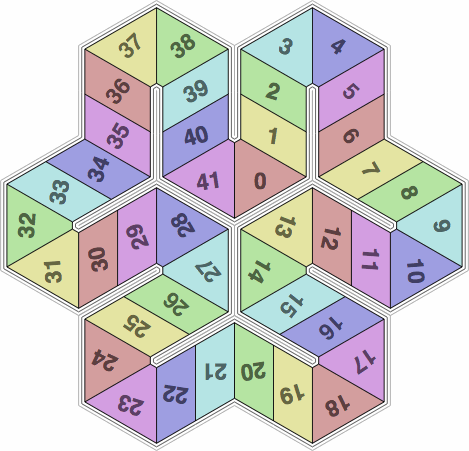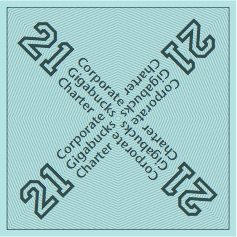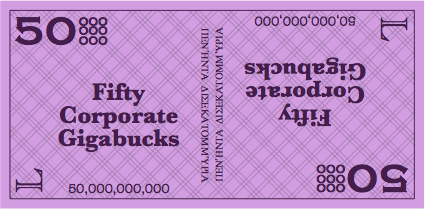board
see more

Who says that rampant, unchecked capitalistic greed is a bad thing?
Contents.
1. Introduction
2. Necessities
3. Assets
4. Preliminaries
5. Course of play
6. Auctions
7. Royalties
8. Resignation
9. Talk
10. Irregularities
11. Comments
12. Optional rules
13. Abbreviations
14. Colophon
See also the quick reference.
§1 Introduction. When playing the CORPORATE GIGABUCKS board game, your object is to bankrupt your opponents before they bankrupt you. Key features:
Compared to other members of the broad Landlord family of board games, CORPORATE GIGABUCKS has a relatively small element of chance; rather, players have extensive opportunity to employ skill. For much early history of related games, read this.
⇒ A. Roughly four to eight players.
⇒ B. A playing board displaying a track on which are spaces each representing one corporation. These corporations being large and impersonal, they do not even have names but are instead identified merely by numbers. As there is a one-to-one correspondence between corporations and spaces, there is no harm in speaking of "the owner of a space", or referring to "consecutive corporations".
| playing board see more | 
|
⇒ C. Charter documents, each a small card bearing the number of a corporation.
| charter card see more | 
|
⇒ D. Currency representing gigabucks, the smallest denomination being $1,000,000,000 (one gigabuck). Larger denominations are multiples of $1,000,000,000 such as $2,000,000,000 (two gigabucks), $5,000,000,000, $10,000,000,000, and $20,000,000,000. The game is designed so that fractional gigabucks are never necessary.
| currency
see more | 
|
⇒ E. Product line tokens (PrLiTos). These are placed on a corporation's space to show how many product lines the corporation has. All product lines are equivalent, but these tokens come in multiple denominations for convenience when a corporation is highly diversified. The samples in the illustration are marked with Roman numerals for 1, 2, 5, et cetera. PrLiTos should be stackable, and should be small enough to fit into the spaces on the board.
| product line tokens | 
| 
| 
|
|---|---|---|---|

| 
| 
|
⇒ F. One player token (PlTo) per player, all different. A PlTo marks the player's current spot on the playing board.
| player tokens see more | 
|
|---|
⇒ G. One current player token (CuPlTo), for keeping track of whose turn it is.
⇒ H. A pair of ordinary dice.
§3 Assets. These are of two kinds:
⇒ A. Currency. After players receive their initial allotment of currency at the beginning of the game, all transfers of currency are from one player to another. There is no "bank" that emits or receives currency, except that the players may of course exchange equivalent denominations with the unused currency supply, or with each other.
⇒ B. Corporations with their product lines; each product line is signified by a PrLiTo residing on the corporation's space:
Each player receives an allotment of currency, a suggested amount being $300,000,000,000 (300 Gigabucks) per player.
Players by mutual agreement decide who will sit where, and which player goes first. The first player gets the CuPlTo.
Players take turns, moving clockwise around the table. The CuPlTo is passed from one player to the next; this is important because with the large number of auctions, and with many players speaking in most auctions, it is easy to lose track of who the current player (CuPl) is. The details of the different kinds of auctions are given in section 6 below.
On your first turn, you simply place your PlTo in any vacant space; this is flexible placement. You call for a charter auction and after that your turn ends.
The rest of the game is characterized by inflexible placement. On your second and subsequent turns, you begin by rolling the dice and moving your PlTo the indicated number of spaces, without choice. Movement is toward increasing numbers, and the overall direction is clockwise. If the space to which you would move already has somebody else's PlTo, you move to the first vacant space after it; thus there can never be more than one PlTo in a space at the same time. Example:
In the playing board pictured above, space number 0 follows space number 41. Nothing special happens when a PlTo crosses "the break". For instance, if your PlTo is on space 39, and you roll a ten, you move your PlTo to space 7 without complication.
The location of a player's token is termed that player's current space (CuSp).
The following table explains what happens after you move your PlTo:
If you have landed on a corporation that is not yet chartered:
|
If you have landed on a corporation that is inactive because its owner resigned from the game before going bankrupt:
|
If you have landed on a corporation that you own:
|
If you have landed on a corporation that an opponent owns:
|
When your turn ends, you pass the CuPlTo to the player on your left.
§6 Auctions. Here are the details:
| auctions in general | When CuPl calls for an auction:
| ||
|---|---|---|---|
| charter auction (ChAu) | 1. HiBi pays the winning bid amount to each opponent.
2. HiBi becomes the owner of the corporation and receives the charter document for the space that CuPl's token is resting on. Notes:
Example:
| ||
| reactivation auction (ReAu) | This works the same as a ChAu. The corporation retains any product lines it might have already had. | ||
| diversification auction (DiAu) | 1. HiBi decides how many product lines to buy, and announces the number. The minimum is one, and the maximum is whatever HiBi can afford.
2. HiBi pays to each opponent the winning bid amount multiplied by the number of product lines being purchased. 3. HiBi adds PrLiTos to those corporations that HiBi wants to diversify. Notes:
Example:
| ||
| voluntary liquidation auction (VoLiAu) | 1. CuPl specifies which of his/her corporation(s) are to be sold. It might be one specific corporation, a combination of several specific corporations, or the right to choose one or more corporations from a list that CuPl announces.
2. CuPl specifies a minimum bid. Only in a VoLiAu can the minimum bid be more than $1,000,000,000. 3. HiBi pays the amount of the bid to only CuPl, and receives the the charter document(s) for the corporation(s) in question. Notes:
Example:
|
§7 Royalties. When one player owns two or more corporations housed on consecutive spaces, the aggregate of them is called a conglomerate. In the board illustrated above, spaces 41 and 0 are deemed consecutive.
If the owner of a corporation does not own either of the adjacent corporations, this lone corporation can still be regarded as a conglomerate whose size is one.
When CuPl lands on a corporation owned by an opponent, royalties must be calculated; all of a conglomerate's corporations are taken into account:
Here is a detailed example. Suppose CuPl lands on space 28, and one opponent owns all of corporations 24 through 31:
| space | PrLiTos | royalty | ||
|---|---|---|---|---|
| OtSp | 24 | 4 | min (4, 3, 2, 0, 4) | $0 |
| OtSp | 25 | 0 | min (4, 3, 2, 0) | $0 |
| OtSp | 26 | 2 | min (4, 3, 2) | $2,000,000,000 |
| OtSp | 27 | 3 | min (4, 3) | $3,000,000,000 |
| CuSp | 28 | 4 | min (4) | $4,000,000,000 |
| OtSp | 29 | 5 | min (4, 5) | $4,000,000,000 |
| OtSp | 30 | 1 | min (4, 5, 1) | $1,000,000,000 |
| OtSp | 31 | 6 | min (4, 5, 1, 6) | $1,000,000,000 |
| total | $15,000,000,000 | |||
Then CuPl pays the owner $15,000,000,000. Had CuPl landed instead on corporation 25, no payment would be due, as the calculation of each minimum would include zero.
The calculation of royalties is based on the state of the board at precisely the time that CuPl lands on a space. In particular, the amount is figured before the effect of any auction that CuPl might call for. No adjustments are made if subsequent changes in corporate ownership or product lines would affect the amount.
§8 Resignation. A player can quit the game before going bankrupt by resigning. The announcement can be made at the beginning of his/her turn, at the end of his/her turn, or between other players' turns. Two things then happen:
Any remainder from distributing the resigner's currency waits until the number of players in the game has been reduced to the point where it equals the number of gigabucks in that remainder.
However, if two or more players resign in rapid succession, their respective leftover funds can be combined for possibly speedier distribution.
The resigner has no voice in the distribution of his/her assets.
§9 Talk. Open discussion is always permitted, no matter whose turn it is, as long as it does not interfere with the game action.
If a player says anything pertaining to the facts of the game, the statement must be truthful. This applies to such matters as whose turn it is, how much currency some player has, who owns what corporations, how many product lines they have, et cetera.
A player may suggest to another some particular course of action; or may announce an intended course of action for self, even going so far as to propose a specific deal. Example:
A. If it is discovered that the apparent HiBi in any auction has insufficient currency to pay the full obligation:
B. If the wrong player takes a turn, and nobody objects before some subsequent player rolls the dice, then that wrong player becomes by fiat the correct current player. The clockwise rotation of players' turns continues from this newly-declared current player, and no accommodation is made for the players whose turns were skipped.
C. Should CuPl fail to pay royalties when due, any player may object, and may further insist that InLiAus be held if necessary. This is to prevent agreements of royalty forgiveness between players.
D. A player is supposed to announce resignation only when no player is taking a turn. However, if a player does abandon the game during his/her turn, or during some other player's turn, the general principle is that the resignation should become effective when CuPl's turn ends. Examples:
§11A Auctions.
1. Very few board games, even within the Landlord family, employ auctions as much as CORPORATE GIGABUCKS does.
2. Except in the VoLiAu, the minimum bid is $1,000,000,000, which is a modest amount. Thus in most auctions, it is almost certain that somebody will bid something.
3. In a ChAu, ReAu, or DiAu, all players pay or receive currency; by contrast in a VoLiAu or InLiAu only HiBi pays and only CuPl receives.
4. The game does not predefine the cost of charters or product lines; this allows them to be sold at whatever price the market commands, as established at auction. This feature affords players great latitude for shrewd financial judgement.
5. Assets never change hands except through the official auction mechanism; there is no direct dealing between players. This is to discourage cartels. However, in any multi-player game it is difficult to prevent secret confederacies.
6. The flexible placement round is to ensure that every player has had a substantial chance to buy a corporation before product line auctions begin. Were only one player to own corporations, then he/she could purchase huge numbers of product lines at uncompetitive auction, paying the minimum.
§11B General.
1. The prefix giga- is used in its scientific sense, meaning 10 to the 9th power. In many nations, the word billion denotes this number; elsewhere this number is called a milliard or a thousand million, with the word billion being reserved for 10 to the 12th power.
2. Throughout the game, corporations will gain product lines and conglomerates will be extended, increasing the royalties they can earn. However, the total amount of currency in the game is constant. The certain result is that at some point players will start going bankrupt, if they do not resign first. This zero-sum characteristic is quite rare among games of the Landlord family.
3. CORPORATE GIGABUCKS is good for a large number of players, because every player gets to speak as a bidder almost any time that any player takes a turn. A player need never face a long period of inactivity while others are busy.
4. If a player is adding product lines to some, but not all, of the corporations in a conglomerate, it is generally most profitable to add the product lines to those corporations that have the fewest product lines. In other words, it is advisable (but not required) that the distribution of PrLiTos among the spaces of a conglomerate be approximately balanced.
5. The only element of chance is from the roll of the dice. Because each player will have many turns, good luck and bad luck will usually reach an approximate balance in the long run. All spaces are equally likely to be landed on, and all corporations have equal potential.
6. It is not poor sportsmanship for a player to resign if prospects of victory are dim.
7. While the original version of the Landlord game was to some extent an effort to teach economic morality, CORPORATE GIGABUCKS has discarded so many typical features of the Landlord family to have become something very close to an abstract strategy game.
8. A British version of the game might be called GIGAQUID LIMITED.
§12A Auctions.
1. If nobody meets the minimum bid in a VoLiAu, CuPl may establish a new mimimum bid, at least $5,000,000,000 less than the original. Then another VoLiAu immediately takes place in CuPl's same turn.
2. Instead of confining players to the fixed counterclockwise sequence of entering bids during an auction, a freer scheme where any player may voice a bid at any time can be adopted. Necessary will be a means to resolve a standoff when two players announce equal bids at the same time.
3. Some or all of the auctions can be limited to one round in order to keep the game moving. This is most applicable to auctions for chartering and diversifying, which will occur frequently. On the other hand, auctions for reactivation and liquidation occur less often, and they can involve corporations of substantial value having many product lines. Hence a multi-round auction is best for allowing the full value of the corporation to be realized.
4a. If players want multi-round auctions to go faster, they can establish a coarser granularity for bids. For instance, bids for charters, reactivations, and product lines would be multiples of $2,000,000,000 instead of $1,000,000,000. For liquidations, a multiple of $5,000,000,000 is a possibility.
4b. On the other hand, players who prefer a finer granularity in bidding can achieve this indirectly by increasing the base unit of royalties from $1,000,000,000 to $2,000,000,000, and increasing each player's initial allotment of currency from $300,000,000,000 to $600,000,000,000. Under this plan, the minimum bid and the minimum raise remain $1,000,000,000.
5. In the standard rules, the CuPl is always the player at the previous CuPl's left, without regard for who might have won any auction. A variant is this:
§12B Royalties.
1. Players who find the rule for calculating royalties too complicated can try this: the payment is $2,000,000,000 per product line on the current space, and $1,000,000,000 for each product line elsewhere in the conglomerate.
2. For higher payments, the royalty can be calculated by multiplication: $1,000,000,000 times the number of PrLiTos on the CuSp times the number of PrLiTos in the entire conglomerate, including the CuSp. An initial allotment of currency much larger than $300,000,000,000 is probably in order. Examples:
§12C Others.
1. Under the original rules, each player has one turn at flexible placement. This can be extended to two or three turns, with inflexible placement thereafter.
2. For a faster game, distribute less currency at the beginning of play, or use a board with fewer spaces.
3. Although the rules above assume players will use two six-sided dice with numbers 1 through 6, many other kinds are available.
4. The standard rules presume that players can by friendly agreement decide who sits where, who gets which PlTo, who plays first, who plays second, et cetera. If players are so contentious as to make this impossible, the matter can be resolved by auction. Here is an example with a six-person game:
5. For a greater level of excitement, players can use real money. All players should begin the game with equal amounts to ensure competitive balance. Any corporations of a resigning player are disposed of at ReAu in the usual fashion; but in a deviation from the usual rules, the resigner keeps his/her remaining funds.
Pertaining to auctions:
This page was prepared on an Apple Macintosh running OS X. The html was written with an ordinary text editor, but the images were a little more complicated: